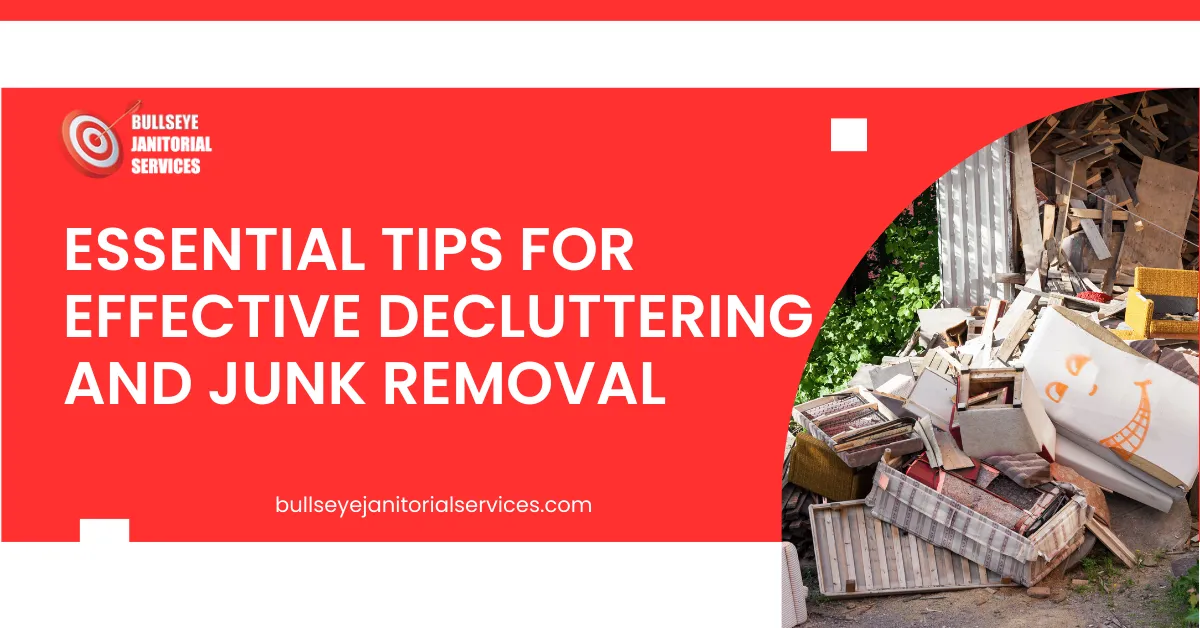Essential and Effective Decluttering and Junk Removal Tips
Decluttering isn’t just about tidying up or making your space look more organized. While that’s an obvious benefit, the process of decluttering goes much deeper, affecting both your physical environment and your mental well-being. In a cluttered world, the act of organizing and minimizing unnecessary items has become not only a lifestyle choice but also a necessity. Whether you’re preparing for a move or simply refreshing your current living space, a well-structured decluttering strategy can lead to significant improvements in your daily life.
One of the biggest reasons why decluttering is so important is the impact it has on your mental health. Research has shown that clutter can trigger stress and anxiety. When your space is full of items you don’t need or use, it can create a feeling of being overwhelmed and out of control. Studies have found that clutter can raise cortisol levels, which is the stress hormone. Higher levels of cortisol can lead to feelings of anxiety and tension, making it more difficult to focus and relax.
This comprehensive guide offers expert decluttering and junk removal tips, helping you create a tidy, functional living space. It covers essential strategies and the advantages of hiring professional junk removal services.
Establish a Comprehensive Decluttering Plan
The foundation of a successful decluttering project lies in a structured, well-thought-out plan. Jumping into the task without a clear strategy can lead to frustration and overwhelm. An effective decluttering plan allows you to approach the process methodically and avoid burnout.
Conduct a Thorough Assessment:
Before you begin, take stock of your home and assess which areas need the most attention. Is your kitchen overflowing with unused gadgets? Are your closets stuffed with clothes that haven’t been worn in years? Take notes on which spaces require the most significant effort, and prioritize them accordingly.
Segment Your Space into Manageable Zones:
Decluttering an entire home at once can quickly become an overwhelming task. Instead, break down your space into smaller, more manageable zones. This could mean focusing on a single room at a time or even narrowing it further to specific sections of a room (e.g., closet, drawers, or pantry). By working within defined areas, you reduce the feeling of being overwhelmed, stay focused, and ensure steady progress.
Set Realistic Timelines:
Be honest with yourself about how much time each area may take to declutter. It’s important to set realistic expectations about the time commitment for each zone. Decluttering, especially if it involves sentimental items or a significant amount of clutter, may take longer than anticipated. By breaking down the process into specific milestones and assigning time frames to each, you’ll be able to stay motivated as you reach each checkpoint. Allow for flexibility in your timeline, as unexpected challenges may arise.
Start Small for Maximum Momentum:
Beginning with smaller, less cluttered areas such as a closet, a kitchen drawer, or a bathroom cabinet will help you build momentum and confidence. Completing these smaller tasks allows you to witness the immediate benefits of decluttering, which will give you the motivation to tackle more complex areas. Once you’ve cleared up smaller zones, you’ll feel more equipped to tackle larger rooms, such as the living room, bedrooms, or the garage.
Select Appropriate Junk Removal Methods
Once you’ve decided what to keep and what to dispose of, it’s crucial to determine the best approach to handling the items you no longer need. Proper junk removal is not only about getting rid of things but doing so responsibly. The disposal process should align with both environmental sustainability and social responsibility.
Categories for Junk Disposal:
Donation:
Usable items that are still in good condition, such as clothing, furniture, kitchenware, and books, can be donated to local charities, thrift stores, or nonprofit organizations. Donating these items not only helps reduce waste but also provides others with useful goods. Before donating, ensure that items are clean, functional, and free from damage. Check with local organizations about their donation requirements and procedures, ensuring your contributions are aligned with their needs.
Recycling:
Many household materials, such as paper, glass, metals, and certain plastics, can be recycled. Properly sorting and separating recyclable items from non-recyclable ones will ensure that they are processed correctly. Look for a nearby recycling facility or utilize curbside recycling programs offered by your local municipality. In addition, specialized programs exist for recycling electronics, such as old phones, computers, or televisions, which should be disposed of through certified e-waste programs to avoid environmental harm.
Hazardous Waste Disposal:
Some items, such as old batteries, chemicals, paint, cleaning products, and certain electronics, require special handling and disposal. These items are classified as hazardous waste, and improper disposal can lead to environmental contamination. Always research and identify local services that provide safe disposal methods for hazardous materials. Many cities offer designated days or collection centers for hazardous waste disposal, ensuring these items are handled in compliance with safety regulations.
Professional Junk Removal Services:
For larger or more challenging items—such as heavy furniture, old appliances, or debris from home renovations—consider utilizing professional junk removal services. These services specialize in the removal and disposal of bulky or difficult-to-manage items. They are equipped with the necessary tools and knowledge to safely handle and dispose of items in accordance with environmental guidelines. Professional services also save time and effort, especially when dealing with substantial clutter.
Execute a Room-by-Room Decluttering Method
A room-by-room approach is often the most effective way to declutter your space. By focusing on one area at a time, you will remain organized and avoid feeling overwhelmed. Moreover, it allows you to make gradual progress while maintaining a sense of accomplishment. Below is a more detailed guide on how to approach decluttering in specific rooms:
Kitchen:
Kitchens accumulate a variety of items, from expired food to unused gadgets. Start by sorting through the pantry and refrigerator, discarding expired or outdated food items. Follow this with organizing and removing kitchen gadgets or utensils that are no longer useful. Evaluate the condition of your cookware, dishes, and glassware—if any are broken or in excess, consider donating or disposing of them. Maximize cabinet space by grouping similar items and utilizing organizers to increase accessibility.
Living Room:
The living room, being a central gathering space, often becomes cluttered with entertainment equipment, décor, and other miscellaneous items. Begin by evaluating your furniture. Are there pieces you no longer use or need? Look through your entertainment systems for outdated electronics, broken devices, or unnecessary accessories that can be discarded or recycled. Reorganize bookshelves, storage units, or decorative shelves to optimize space. Ensure that only items contributing to the functionality or aesthetics of the room remain.
Bedroom:
The bedroom should serve as a peaceful and relaxing retreat, but it often becomes overwhelmed by clothing, shoes, and miscellaneous items. Sort through your wardrobe, removing clothes that haven’t been worn in the past year. Donate items in good condition and discard those that are damaged. Clear your bedside tables, closets, and drawers of anything unnecessary, and reorganize the remaining items to create a more serene atmosphere. You may also want to consider investing in storage solutions, such as drawer dividers or under-bed storage, to further streamline the space.
Garage/Basement:
Garages and basements often function as catch-all storage areas, which means they tend to accumulate clutter over time. Begin by tackling any broken tools, unused equipment, or seasonal items that aren’t actively needed. As you declutter, categorize items into functional categories such as gardening tools, camping equipment, or holiday decorations. Consider implementing vertical storage solutions, such as shelving or wall hooks, to maximize the available space and make it easier to access items when needed.
Prioritize Eco-Friendly Junk Disposal
As sustainability becomes a growing priority for individuals and communities, it is essential to approach junk removal with environmental consciousness. Disposing of items in an eco-friendly manner reduces your environmental impact while contributing to a cleaner planet.
Donate Usable Goods:
Instead of throwing away functional items, donate gently used clothing, furniture, and household goods to local charities. This approach reduces landfill waste and helps others in need. Many organizations accept donations year-round and will provide tax receipts for your contributions.
Recycle Materials:
Ensure that recyclable materials such as paper, glass, plastic, and metal are sorted appropriately and taken to recycling centers. Many municipalities offer curbside recycling programs, making it easier for you to responsibly dispose of recyclables. Additionally, consider recycling old electronics through certified e-waste programs.
Compost Organic Waste:
For organic waste, such as food scraps and yard clippings, consider composting. Composting not only reduces landfill waste but also creates nutrient-rich soil for gardening or landscaping purposes. Composting is an environmentally friendly practice that can have a significant impact on your sustainability efforts.
Choose Junk Removal Services with Eco-Friendly Practices:
Many professional junk removal services focus on sustainability by implementing recycling programs, donating usable items, and disposing of waste responsibly. When selecting a junk removal service, ask about their environmental practices and confirm they follow eco-friendly disposal methods.
Use a structured junk hauling checklist
A junk hauling checklist ensures that no steps are overlooked during the decluttering and disposal process. It serves as a roadmap for the entire operation, ensuring efficiency and accountability.
Essential Junk Hauling Checklist:
- Categorize Items: Organize items into groups—what to keep, donate, recycle, or dispose of.
- Gather Supplies: Make sure you have the necessary tools—boxes, trash bags, gloves, and labels for easy sorting.
- Schedule Drop-Offs or Junk Removal Services: Plan and schedule trips to donation centers, recycling facilities, or junk removal services to ensure timely and organized removal.
- Clean and Sanitize: Once the decluttering is complete, thoroughly clean the area. This will ensure the space is fresh and inviting.
Conclusion
When you take the time to declutter home or office, you are actively creating an environment that supports your well-being and happiness. It’s an investment not just in your space, but in your peace of mind.Whether you choose to tackle decluttering yourself or enlist professional help you need a proper plan. Dedicating yourself to the process not only clears your physical space but also nurtures mental clarity, leading to a more organized and peaceful lifestyle.
Contact us now to know more about strategies of decluttering your space.



